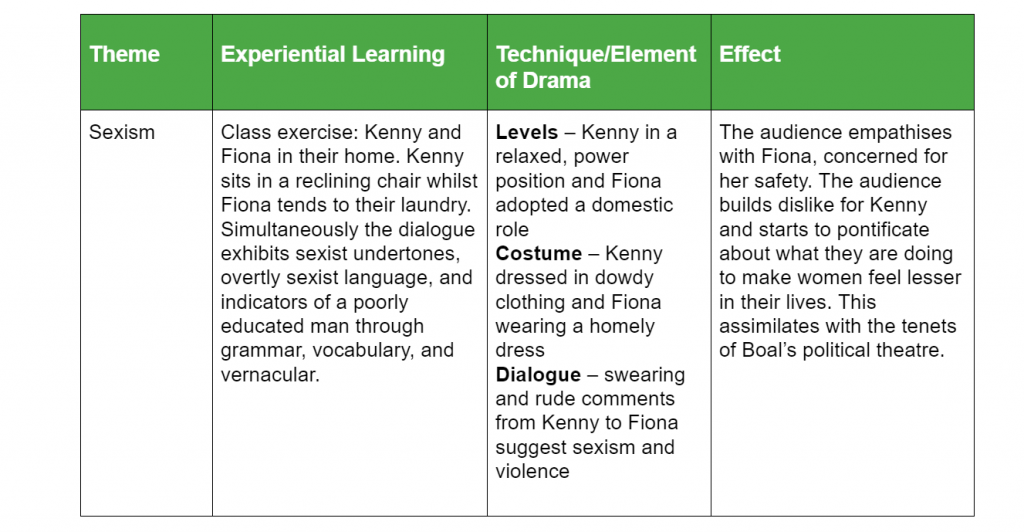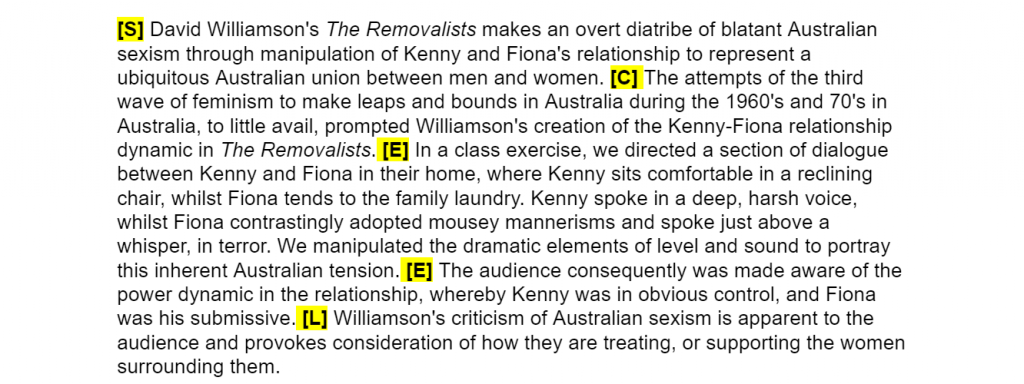
Want to nail your HSC Drama essay in the HSC exam? Or, maybe only just realised that you have to write a HSC Drama essay in the exam and need some help?
You’ve come to the right place!
We’ve come up with this 5 step guide to writing a Band 6 worthy HSC Drama essay by breaking down the rubric and giving you tips on how to understand your text, analyse it and write about it!
So, what are you waiting for? Let’s jump in!
The HSC Drama Essay
Step 1: Understanding the Bands and the Rubric
Step 2: Understand your Texts
Step 3: Use TETE Tables
Step 4: Answer the Question
Step 5: Draft, Rewrite, Polish
The HSC Drama Essay
Drama essays are often overlooked because most kids take Drama to do the practical/acting components.
In reality, the theory tasks are the most influential on your final mark. The theory exam is worth 40% of your external mark!
Honing your HSC Drama essay writing skills will take you straight to the top, believe me!
Most Drama students forget to study for the written exam until it’s too late. Getting this skill under your belt early will put you well ahead the rest of the pack.
This article is here to help you with any trouble you’ve had with Drama Essays in the past, in 5 simple steps! Let’s go!
Step 1: Understanding the Bands and the Rubric
What is a Band?
Bands are the system NESA uses to grade each of your exams in the HSC.
Your results will be placed in a certain Band based on your percentage results. There are six bands, Band 6 being the highest and most difficult band to achieve.
It is easy to think of the Bands with reference to their percentages:
- Band 6 – 90-100%
- Band 5 – 80-89%
- Band 4 – 70-79%
- Band 3 – 60-69%
- Band 2 – 50-59%
- Band 1 – 0-49%
Rubric
The only way you can understand a rubric is if you translate into language that you understand.
As an example, I have taken the Australian Drama and Theatre Rubric (the HSC Drama Core Study) and broken it down into simpler terms.
Australian Drama and Theatre (Core Study)
This topic explores, theoretically and experientially, the traditional and contemporary practices of Australian drama and theatre and the various ways in which artistic, cultural, social, political and personal issues and concerns are reflected in different contexts. Students investigate how different Australian practitioners use dramatic forms, performance styles, techniques and conventions to convey ideas and influence the ways in which audiences understand and respond to ideas and images presented in the theatre.
I have bolded the important terms. Every exam question that you will get, or practice, will be derived from this rubric. It is paramount that you understand this.
In essence, NESA is saying that in this unit, you will research and act out your set texts to get a rich and deep understanding of how the playwrights explore contextual Australian issues.
These may surface in the form of a reflection, diatribe, subtle comment, or ramification of the artistic, cultural, personal and social imperatives of Australia in the plays’ contexts.
Your job, as the student, is to analyse how the playwrights wrote their plays, and what techniques they used (appropriate to the styles of Australian Theatre) and what they wanted the audience to feel/think after watching their play!
Step 2: Understand your Texts
Read your texts
Obviously, the first step to understanding your texts is by reading them! If you were thinking that you could get away without reading your texts, let me tell you now that that is not an option – especially if you want to write a Band 6 worthy HSC Drama essay!
Make sure you understand the text and can recount it off the top of your head if you were asked.
For an example, let’s use The Removalists by David Williamson (1971).
This play is about two police officers, one a senior officer and the other is the new cop on the block, who helps a young woman and her sister, who is being abused by her husband, to move out of the house and return her to safety.
Extrapolate the important themes
Once you’ve read your text, you need to be able to identify the most important themes from the text.
Usually, your themes will be quite apparent as they will be linked to the central idea of the text you’re studying.
For example, in The Removalists an example of a core theme of the play is sexism. This apparent sexism is a reflection of the blatant sexism in Australia in the 1970s.
Step 3: Use TETE Tables
You may know them as TEE Tables from previous English essays you have written, however, HSC Drama essays are slightly different.
You will be using a TETE table instead for Drama to break down your paragraph into a set of columns to build up an in-depth collection of evidence to support your essays!
You will be using a table much like this one. I have filled it out using an example from David Williamson’s The Removalists to show you how it works.

I know this can be tedious, and no one ever said that writing an essay was a hobby, but if you work hard now, you will reap the rewards later!You should have one of these in every paragraph, giving you 4 for a Drama Extended Response.
Step 4: Answer the Question
Like any essay, we need to come up with a strong thesis.
In order to do this, we need to be able to understand what the question is asking. This might involve highlighting the key words of the question and asking ourselves what it is that the question wants us to do.
Let’s try doing this with the following practice question:
Compare how the plays that you have studied use the development of tension to take their audience on a particular journey.
Firstly, let’s break up the question by identifying the key words:
- Compare
- Development of tension
- Audience on a particular journey
From here, we can ask ourselves three mini questions, pulled from the essay question, to really understand what NESA wants us to answer:
- What tensions are in the two plays I have studied?
- How do the playwrights develop these tensions – What dramatic techniques/elements do they use?
- How are these two things different in the two plays?
It is important that you answer these questions in the introduction of your essay, as it will show the marker that you have understood and addressed the question.
Be sure to link back to these questions throughout the essay to reinforce your response.
The next step is to write paragraphs which more specifically address the question!
Writing Paragraphs
In each paragraph, you should follow this structure: SCEEL!
- Statement – A topic sentence which refers to the question, the set text and a theme in the text.
- Context – A sentence about the context of the play, which is relevant to the themes you will be discussing in the paragraph.
- Example – Experiential learning. Include an example from the text which supports your argument.
- Explain– Explain the elements of drama included in the example and how they highlight the presence of the theme. Then, discuss the effect on the audience.
- Link – Make a statement which links to the next paragraph, as it will be a comparison/contrast paragraph.
Let’s look at an example SCEEL Paragraph:

As you can see, it is very different to an English paragraph. You do not need to use fancy or superlative language. Just be sure to write clear sentences that do not cloud your thesis.
Step 5: Draft, Rewrite, Polish
First Draft
The key to a good first draft is by reading over the question, breaking it down, and creating a dot-point plan of what you’d like to say in your response.
You should mention themes, the experiential learning you’re planning on using and so on. The essay doesn’t need to be perfect just yet. Just have a crack at writing!
Second Draft
Turn your first draft into full and proper sentences.
Be sure to pay attention to spelling, grammar, and sentence structure! If you pay attention to these things in practice essays, you will be ready to go for the real thing.
Turn your scaffolded paragraphs into 250-300 word paragraphs, and make sure that the experiential learning reads clearly, as you are often portraying a scene with movement and visuals.
Third Draft
This is the time to pick up on things that you feel need improvement.
You want to aim to increase the flow of the essay.
Put your laptop into ‘review’ mode so that you can track any changes you make.
There you go!
That’s the most boring part of the course covered and done with a Band 6. Now you can get back to the good stuff… acting!
This is a full-on guide to smashing the HSC Drama essays, so thank you for sticking with me – you will be better off for it!
With these techniques and steps, you have the ingredients to make a wonderful HSC Drama essay!
Looking for some extra help with HSC Drama?
We pride ourselves on our inspirational HSC Drama coaches and mentors!
We offer tutoring and mentoring for Years K-12 in a variety of subjects, with personalised lessons conducted one-on-one in your home or at our state of the art campus in Hornsby!
To find out more and get started with an inspirational tutor and mentor get in touch today!
Give us a ring on 1300 267 888, email us at [email protected] or check us out on Facebook!
Lucinda Smith-Stevens graduated from Pymble Ladies’ College in 2016. She is an intern at Art of Smart. She hopes to study a Bachelor of Arts at the University of Sydney in 2017, focusing on Media and Communications subjects. Lucy loves drama and public speaking, having completed a CVCA diploma in Speech and Drama. Lucy is also passionate about helping other students through the HSC in humanities subjects, General Mathematics 2 and essay writing skills.


